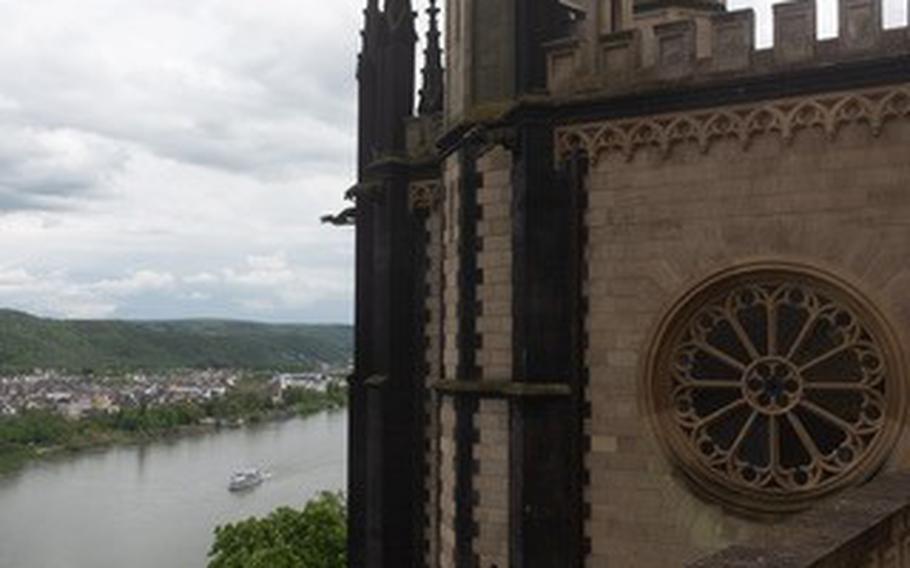
A boat cruising on the Rhine River on May 6, 2023, approaches the chapel of Schloss Stolzenfels in Koblenz, Germany. Prussian Crown Prince Frederick William IV renovated the dilapidated fortress in the 1830s based on similar projects during the era of romanticism in Europe. (David Edwards/Stars and Stripes)
One of the first items I received after I moved to Germany two years ago was a poster of the “top 25 castles in Europe.”
My itineraries for many subsequent excursions around the Continent were set with an eye toward putting an X into as many of the accompanying boxes on the poster as possible, and a just-completed trip brought the number to 11.
But on my way home last year after a Thanksgiving weekend visit to a Rheinland-Pfalz spa town, my attention was wrested from the road in the vicinity of Koblenz by two castles not on the poster, a beguiling burg and a showy schloss.
The former, Burg Lahneck, also enticed the history buff and literature lover in me.
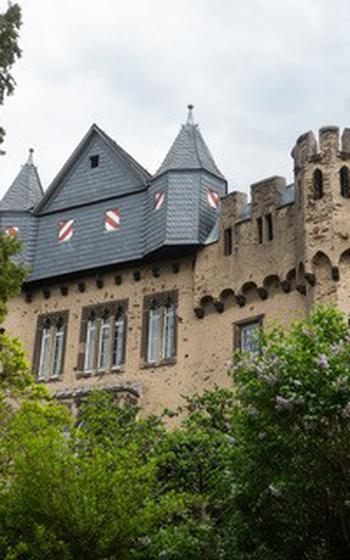
Burg Lahneck in Lahnstein, Germany, is shown before a tour May 6, 2023. Legend holds that after years of persecution, the last 12 Knights Templar fought to the death at the castle in 1312. (David Edwards/Stars and Stripes)
According to legend, it was the scene of the last stand of the final dozen Knights Templar, who are said to have fought to the death there in 1312 after five years of relentless persecution begun by France’s King Philip IV and continued by the archbishop of Mainz.
Centuries later, the castle inspired a poem by Goethe titled “Geistesgruss,” meaning “Ghost Greetings.” The opening stanza says “High up on the ancient tower stands / The hero’s noble ghost, / Which, whenever a boat passes by, / Bids it a fair journey.”
Despite a lofty perch over the Lahn River near its confluence with the Rhine, the castle is somewhat secluded from the surrounding town of Lahnstein.
I visited on a sunny Saturday in May and found the crowds at the castle surprisingly tiny. Because of carelessness, I missed the tours starting at noon and 1 p.m., so I ordered lunch at the restaurant just outside the entrance gate.
The outdoor tables afford patrons a magnificent view of Burg Lahneck’s left-bank neighbor, Schloss Stolzenfels.
When I showed up at 2 p.m. at the Lahneck entryway, the group consisted of just me and the guide. Tours are conducted exclusively in German, but a booklet in English is offered.
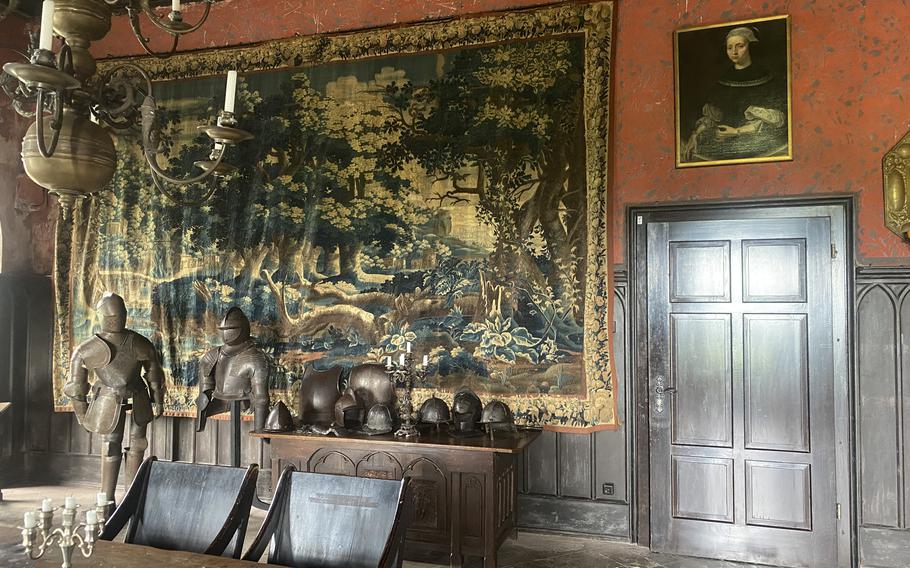
The interior of Burg Lahneck, a 13th-century castle in Lahnstein, Germany, is decorated with tapestries, paintings, antique furniture and Delft china. (David Edwards/Stars and Stripes)
During the 40-minute sessions, participants are shown an assortment of exquisitely furnished rooms. I also was escorted to a balcony with a commanding view of the languid Lahn and the buildings far below.
A gargantuan portrait of Britain’s Queen Victoria commemorates the travels she made in Germany around 1845, and I found the decorative touches in the chapel striking as well.
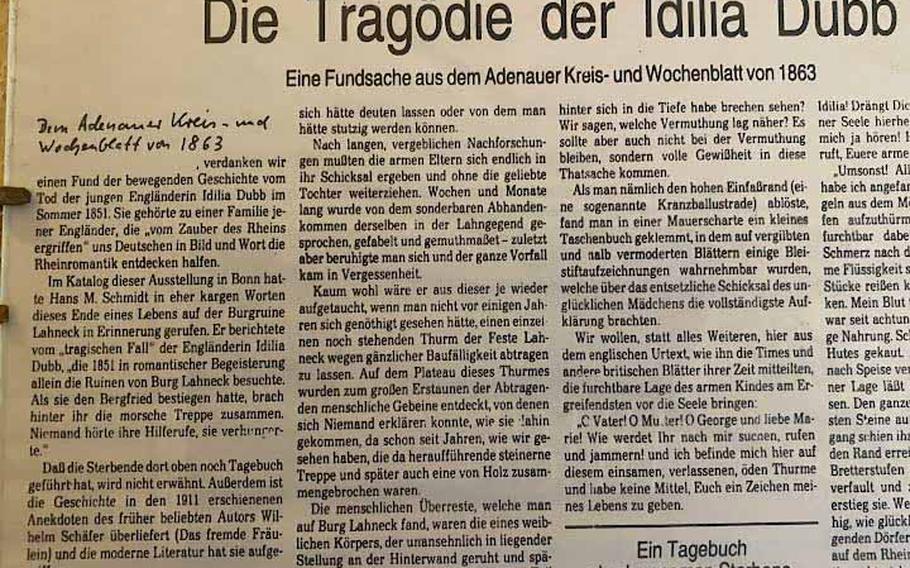
A tour of Burg Lahneck shows a detailed account in German of the tragic death of Idilia Dubb, a 17-year-old Scottish girl who succumbed to starvation after being trapped in the tower of the ruined castle in 1851. (David Edwards/Stars and Stripes)
Another feature of the castle is a recounting of the tragic story of Idilia Dubb, a 17-year-old Scottish girl whose family was vacationing nearby at a time when Burg Lahneck was in ruins.
As she climbed to the top of the keep, the decrepit wooden staircase collapsed, trapping her in a place where no one heard her cries for help. Workers restoring the castle a decade later found her remains and her diary, which documented her starvation.
After a last look around, I headed across the river to Schloss Stolzenfels.
The hulking castle dominates its surroundings. It took its current form in the 1830s thanks to a renewal project initiated by Crown Prince Frederick William IV of Prussia, whose realm had come to encompass the Rhineland roughly 15 years earlier.
Everything I encountered there was pleasurable, from the placid stroll through the lush greenery surrounding the castle to the sights inside to the expansive views of the Rhine.
In particular, I marveled at the pergola garden and the chapel, with its fine stained glass windows. And it almost defied belief that the calming canopy of foliage is right on the edge of full-on urban bustle.
Given that the castle is within Koblenz, it only makes sense to have a look around the city as well.
The Deustches Eck, or German Corner, features a monument at the confluence of the Rhine and the Mosel and is among the most visited places in the region.
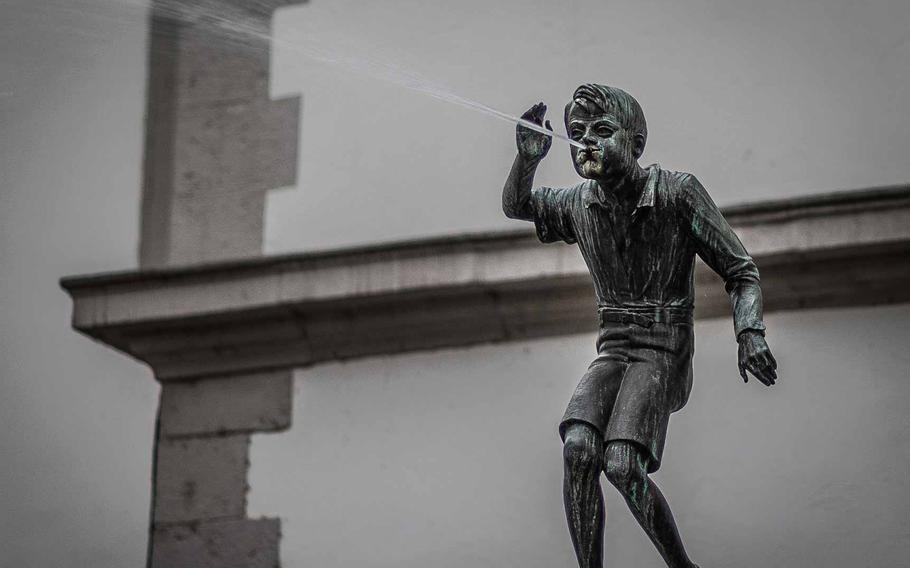
The Schaengelbrunnen is a beloved fountain on the square next to City Hall in Koblenz, Germany. It is topped by a little boy, known as Schaengel, who spits water at passers-by and has become emblematic of the city. (David Edwards/Stars and Stripes)
The Schaengelbrunnen statue of a boy spitting water also has become a symbol of Koblenz, and there’s plenty to do while wandering the city center. Top it all off with a raspberry milkshake at Adaccio, or if you’re like me, have two of them.
But even if your time is limited, the castles alone make for a worthwhile day trip. And if there’s ever an honorable mention list for that poster I received, Lahneck and Stolzenfels definitely deserve a place on it.
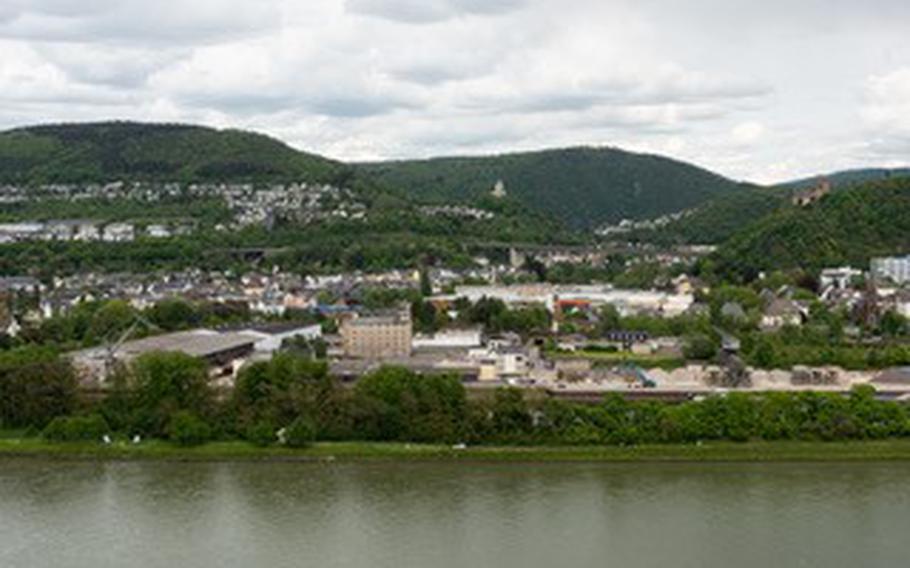
The town of Lahnstein sits on the right bank of the Rhine River across from Schloss Stolzenfels. It flanks the 13th-century fortress Burg Lahneck, which can be seen here on the far right on May 6, 2023. (David Edwards/Stars and Stripes)
On the QT
Address: Burg Lahneck, Am Burgweg, Lahnstein, Germany; Schloss Stolzenfels, Schlossweg 11, Koblenz, Germany
Hours: Burg Lahneck, Tuesday-Sunday until Nov. 1, tours at 11 a.m., noon, 1 p.m. and 2 p.m.; closed Monday except May 29. Schloss Stolzenfels, Tuesday-Sunday and holidays until Nov. 1, 10 a.m.-5 p.m. (last admission at 4 p.m.); Saturday, Sunday and holidays Nov. 1-30, 10 a.m.-5 p.m.; closed December and January.
Cost: Burg Lahneck’s admission charge is 11 euros for adults and 5 euros for children 4 to 14, cash only. At Schloss Stolzenfels, standard adult admission is 5 euros and 3 euros for youngsters.
Information: Online: burg-lahneck.de/html/gb.html; tor-zum-welterbe.de/de/schloss-stolzenfels